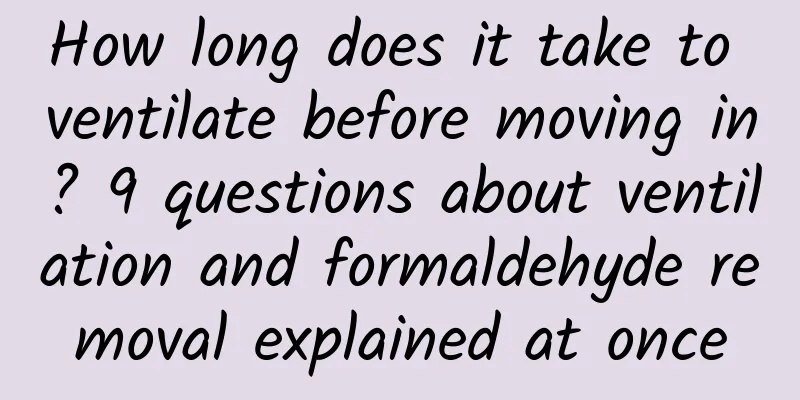How long does it take to ventilate before moving in? 9 questions about ventilation and formaldehyde removal explained at once

|
First of all, the most economical and effective way to remove formaldehyde is indeed to open windows for ventilation. Although many parents have reached a consensus through our persistent popularization of knowledge that windows should be opened for ventilation to remove formaldehyde, there are still many questions about the implementation of opening windows for ventilation. This time we sorted out the 9 most frequently asked questions in the backend, and there must be some questions you are concerned about~ After installing the screen window, there will be a certain resistance to natural ventilation. The specific degree of influence is related to the size of the screen window pores, the thickness of the screen window, and the wind speed. However, the role of the screen window in preventing mosquitoes cannot be ignored. It is still necessary to close the screen window in areas with more mosquitoes. Therefore, whether to open the screen window during ventilation can be determined based on the gaps and thickness of the screen window, as well as the number of mosquitoes. The first thing to be clear is that low temperature will only slow down the release of formaldehyde, not stop it. Therefore, when the indoor temperature is low (such as below 10 degrees), you can appropriately consider the "stuffy storage method". As for the specific "stuffy" and "storage" time, it needs to be determined according to the indoor temperature changes to achieve the best effect. Families with floor heating can choose to open one or two windows by one-third or to an appropriate degree, which can ensure a certain amount of ventilation and promote indoor formaldehyde emissions without lowering the indoor temperature too much. But remember to open all the doors and windows regularly to ventilate thoroughly. For families without floor heating, it is recommended to adopt the "stuffing method" appropriately, giving priority to ensuring the indoor temperature, but the "stuffing" time needs to be shortened (the specific time can be determined according to the changes in indoor temperature) to achieve the best effect. Since rainwater entering the room will affect the walls, floors, and furniture, causing problems such as wall cracks and floor bulging, the size of the windows can be appropriately controlled on rainy days to try not to let rainwater enter the room. Or you can temporarily close the windows when it rains and turn on an air purifier with formaldehyde removal function. For houses that are open at both ends, opening windows for ventilation can quickly achieve air flow replacement without the need for additional fans. If the house is large and has many rooms, or the effective ventilation area of the windows is small (such as limited sliding windows), the ventilation effect of opening the windows will be compromised. At this time, you can add a fan to accelerate the air flow in the room and ensure smooth ventilation of the entire house. The formaldehyde released by the decoration materials can be quickly discharged to the outside. In addition, rooms that use a large amount of artificial boards, such as cloakrooms, bedrooms, and children's rooms, generally release more formaldehyde. You can also add fans to accelerate air flow, reduce indoor formaldehyde concentrations, and promote further release of formaldehyde inside the boards. The main function of a fan is to increase indoor air circulation. Industrial fans are more popular due to their strong wind power, but they are not the only choice. As long as indoor air circulation can be ensured, household fans are also completely acceptable. In addition to ensuring air circulation, the location of the fan is also critical. Through experiments, we found that placing the fan inside the room close to the furniture and blowing it towards the window, while trying to increase the air volume to the maximum, can improve the effectiveness of ventilation and formaldehyde removal. The fresh air system can filter and purify outdoor air before delivering it to indoor areas, and then discharge the polluted indoor air to the outside. Only in this way can a closed room achieve a better purification effect. It is recommended as an alternative when it is inconvenient to open windows. Therefore, there is no need to turn on the fresh air system when opening the window. If you are worried about the poor effect of opening the window, you can add a fan or an air purifier with formaldehyde removal function. After the house is renovated and all the furniture is moved in, it is recommended to ventilate the house for a summer before considering moving in. Because the high temperature and high humidity in the summer is the peak period for the release of formaldehyde and TVOC, keeping the windows open for ventilation can allow the formaldehyde in the decoration materials to be continuously released. Since the specific decoration conditions of each household are different, even if the house is ventilated for a whole summer, it is still recommended that you test the formaldehyde before moving in and only move in if it passes the test. If there are pregnant women or children in the home, it is recommended to control the indoor formaldehyde concentration at a lower level. If you have not yet moved in, it is recommended to continue opening windows for ventilation until the indoor air quality meets the standards before moving in. If you have already moved in, it is recommended to conduct multiple formaldehyde tests in each room while keeping windows open for ventilation to ensure that the formaldehyde concentration in the home is within the safe line. If the formaldehyde concentration is still above the standard, it is recommended to open windows for ventilation and add an air purifier with formaldehyde removal function. Whether it is opening windows for ventilation or other methods of removing formaldehyde, the purpose is to change the living environment, but the premise of changing the environment is to understand the environment. |
<<: The Fly Restaurant, the Last Bite of Human Life in the Wave of Food Industrialization
Recommend
Qin L and Haibao 06 have received a lot of orders. Who is more panicked, the three Japanese giants or domestic competitors?
How crazy can the orders for a car be? You know, ...
Mitsubishi leverages Renault and Nissan's resources to expand into the U.S. and Chinese markets
According to foreign media reports, Mitsubishi wi...
Menopause occurs in both men and women? How to adjust your diet? What should you pay attention to in your life? Huaxi doctors say...
As the saying goes "When you reach middle ag...
How big is the difference between bottled water that costs 1 yuan, 2 yuan, and several hundred yuan?
Expert of this article: Pan Jingwen, Assistant En...
Ten writing secrets taught to me by a world-class master!
"The Shawshank Redemption" is adapted f...
In the movie "Man Jiang Hong", cherries are rare? In ancient times, this was true.
In the movie "Man Jiang Hong" which was...
How do Xueersi, Yuanfudao, Zuoyebang, etc. operate short videos?
Previously, in the future of "Education + Sh...
Why is it not called iWatch because of poverty? Apple, you’ve had enough
Most of Apple's product lines are named "...
What is this thing in the grass that looks like leek?
In the green belts of many cities, you can often ...
Taking Kaola.com as an example, we analyze the event planning process and innovative gameplay
I won’t keep you in suspense here, let me go thro...
Analyze the algorithm mechanism behind Tik Tok!
Understanding the platform rules is the key to pl...
From 0 to 1, how to build a user portrait system?
Starting from the data product level, the article...
We found the customer base, but failed in the investment. Why is B2B marketing so difficult?
Under the new marketing concept, low-cost custome...
How to plan an anniversary event? Teach you step by step
This article is a homework assignment, which is t...
Li Xiaolai 2021 Writing Training Camp
Li Xiaolai’s 2021 Writing Training Camp is being ...









